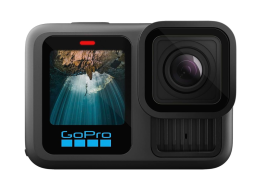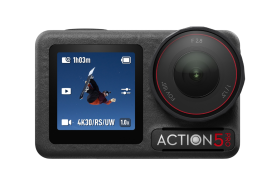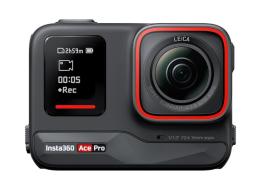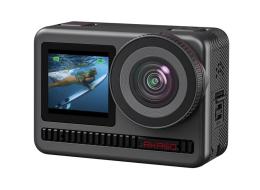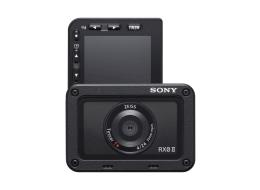Understanding Action Camera Specs: Frame Rate (FPS)

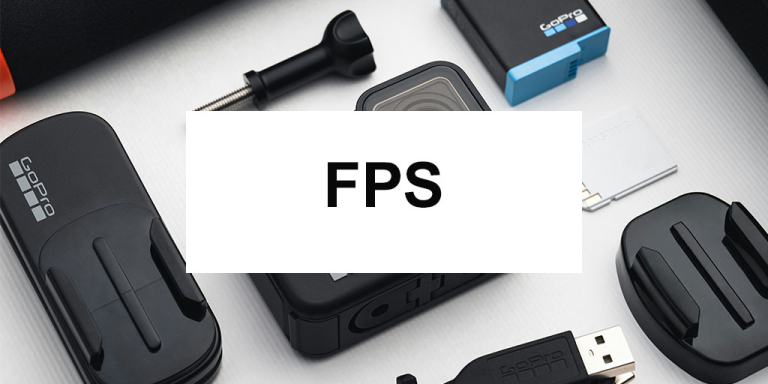
Frame rate, measured in frames per second (fps), denotes how many individual images (frames) the camera captures each second. It directly affects how smooth motion appears and what possibilities you have for slow-motion footage. Common frame rates you’ll see are 24 fps, 30 fps, 60 fps, 120 fps, and 240 fps.
At a standard playback of 30 fps, shooting at:
- 30 fps will play back in real-time (1 second of action = 1 second of video). This is a common default and gives reasonably smooth motion for everyday scenes. It’s roughly equivalent to the frame rate of typical smartphone video or TV news.
- 60 fps captures twice as many frames per second. This makes motion look smoother to the eye – useful for action shots where a lot is happening quickly. For example, fast camera pans or moving subjects will have less motion blur and stutter at 60 fps versus 30 fps. Many action enthusiasts prefer 60 fps for a more fluid lookinsta360.com. Also, 60 fps footage can be played back at 30 fps to achieve a half-speed slow motion (because you recorded double the frames). The result is a smooth slow-motion because those extra frames fill in the gaps.
- 120 fps (or higher, like 240 fps) is typically used specifically for slow-motion capabilities. If you film at 120 fps and then play it at 30 fps, that’s a 4× slow-motion (120/30 = 4) – the action will appear at quarter speed, but still look very fluid because there are 120 frames capturing each second of real time. This is how you see those epic surfing slo-mos or a skateboard trick replayed in crisp slow motion. High fps capture “makes your recording absolutely epic” in slow-mo, as one reviewer enthused. It allows you to see detail in fast events (like splashes of mud from a bike tire or a water droplet flying) that would blur at normal speed.
Smoothness vs. Cinematic Feel
It’s worth noting that traditional movies are shot at ~24 fps, which gives a slightly less smooth, more motion-blurry look that our eyes have come to associate with “cinema.” Some action cams offer 24 fps or 25 fps options to match that look or regional TV standards. Meanwhile, 60 fps and above look ultra-smooth, sometimes described as the “soap opera effect” when used in non-slow-motion contexts. It’s a matter of preference and purpose. For most action footage, 60 fps is a great middle ground for smooth capture. You can always slow it to 30 fps for a mild slow-mo or keep it 1x for extra smooth regular speed.
Typical vs. High-End Example
An older or budget action cam might max out at 1080p 60fps or 4K 30fps. In contrast, recent high-end models (2023–2025) can do feats like 4K at 120fps, or 1080p at 240fps. For example, the DJI Osmo Action 4 and GoPro Hero11 both offer 4K/120fps capability, enabling superb slow-motion at high resolution. At 120fps you can slow down action to 1/4 speed and still get 30fps output – great for dramatic highlight reels. Remember, you can always convert a higher fps to slow-mo, but you can’t magically add frames later if you recorded at too low an fps. So for action sports, err on the side of a higher frame rate if you think you’ll want to savor the moment in slow motion.
Practice: Check out our action camera index page and try to find and compare two action camera models you like, and see which one would be better for fast-action shooting.
Conclusion
In summary, frame rate plays a key role in how smooth your video looks and what creative options you have—especially for slow motion.
Standard rates like 30 fps offer natural motion, while 60 fps adds fluidity and flexibility.
Higher speeds like 120 fps or 240 fps unlock stunning slow-motion playback, perfect for capturing dramatic, fast-moving moments in crisp detail.
Just remember: more frames mean more data and light trade-offs, so match your frame rate to your scene and lighting. When in doubt—especially for action—go higher. You can always slow footage down later, but you can’t add frames you didn’t capture.
Check out part three of the series where we discuss what's FOV (Field of View) and lens quality?
Missed part one? Then go back and learn what is resolution and what is bitrate?
Featured image by Sanju Pandita.
Action Cameras with FPS Options
FAQ
What is FPS?
Frame rate, measured in frames per second (fps), is the number of images captured each second. Higher frame rates result in smoother motion and allow for slow-motion effects. Common frame rates include 24, 30, 60, 120, and 240 fps.
What are common frame rates and what do they mean?
Common frame rates are:
- 24 fps: The standard for cinema, with a “film look” that’s slightly less smooth.
- 30 fps: Typical for smartphones and TV; smooth enough for everyday video.
- 60 fps: Twice as smooth as 30 fps. Ideal for fast motion or action scenes, with less blur.
- 120 fps / 240 fps: Used mainly for slow-motion playback. Lets you slow action to 1/4 or 1/8 speed while keeping it fluid.
How does slow-motion work with frame rate?
The higher the frame rate you record at, the slower you can play it back. For example, if you record at 120 fps and play it back at 30 fps, the footage plays at 1/4 speed with smooth detail.
Is higher frame rate always better?
Not always. Higher fps is great for action and slow-motion, but it can make video look ultra-smooth (sometimes called the "soap opera effect"). For a more cinematic feel, lower fps like 24 is preferred.
Are there downsides to using high frame rates?
Yes. High fps requires more processing power, uses more storage, and may reduce image brightness in low light. Some cameras also lower resolution at high fps (e.g., 120 fps may only be available at 1080p).
Do all cameras support all frame rates at all resolutions?
No. Many action cameras can shoot 4K at 60 fps, but only support 120 fps or 240 fps at lower resolutions like 1080p.
What are examples of high-fps action cameras?
Recent models like the GoPro HERO13 and DJI Osmo Action 5.
What’s the best frame rate for action footage?
60 fps is a solid choice—it looks smooth and can be slowed to 30 fps for subtle slow motion. If you plan to create dramatic slow-motion shots, go for 120 fps or more.
